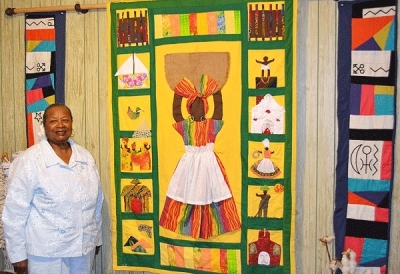Gullah artist Vermelle Smith Rodrigues is a maker of “story quilts” that narrate the history and culture of the Gullah. She uses the quilt as a tool to educate the public about the Gullah people. Her inspiration for the quilt was to create a representation of how the Gullah people came together to continue the legacy of the Gullah’s dreams, hopes, and beliefs. In the center of the quilt, the strong “Gullah Ooman” carries the passions, creativity, and love that the Gullah community lived by. 
The Gullah Museum of South Carolina provides a description on their website about the panels Ms. Rodrigues sewed together.
Clockwise from bottom left:
1. Pyramids – Africa, the origin of all mankind and the Motherland of all African American.
2. House – a peaceful African village in a pastoral agrarian society.
3. People – enjoying village life before the first Europeans arrival.
4. Dove of Peace and Enslavement Net – The first Europeans arrived and were handed the dove of peace; in turn they captured the Africans for the transatlantic slave trade.
5. Slave Ship – slave traders and the beginning of the African diaspora.
6. African holding pens – slaves were held on the West African coast and sea islands (Bunce, Elmina, Goree, and Cape Verde).
7. Middle Passage – (top) the horror, and the bones of millions of African ancestors at the bottom of the Atlantic – those who died or were killed during passage, on the same route that hurricanes now travel.
8. American Holding Pens – Sullivan Island, where 40% of our ancestors entered the American “door of no return” into bondage and despair.
9. Auction Block – slaves were sold as if they were the same as horses or cattle, and the rawhide whip of the overseer.
10. Big House – a planter’s house and outbuildings built by enslaved African craftsmen, symbolizing all that was dehumanizing and evil in slavery, and the many thousands of Africans and Gullahs who lived and died in swampy, pestilence ridden rice fields ante-bellum South Carolina and America wealthy.
11. Big Mama – symbolic of all women on the plantation who did it all – physician, mid-wife, psychiatrist, mediator, liberator, sometimes involuntary mistress to the enslaver, she did all the work of a man, except the heaviest.
12. Staple Crop Field – the sizzling sun on cattle ranges, rice, indigo, and cotton fields where Africans and Gullah not only slave, but taught the Europeans the African methods of such farming, making the Carolinas one of the richest agricultural societies in the 18th century.
13. Religious Building – Traditional African religion – Islamic, Judaic, Christian – that helped us keep faith, through a living hell; until Emancipation, when we were given “nothing but freedom.” The church represents “Watch Night Service,” Dec. 31, 1862. [President Lincoln’s Emancipation Proclamation became law Jan. 1, 1863.]”